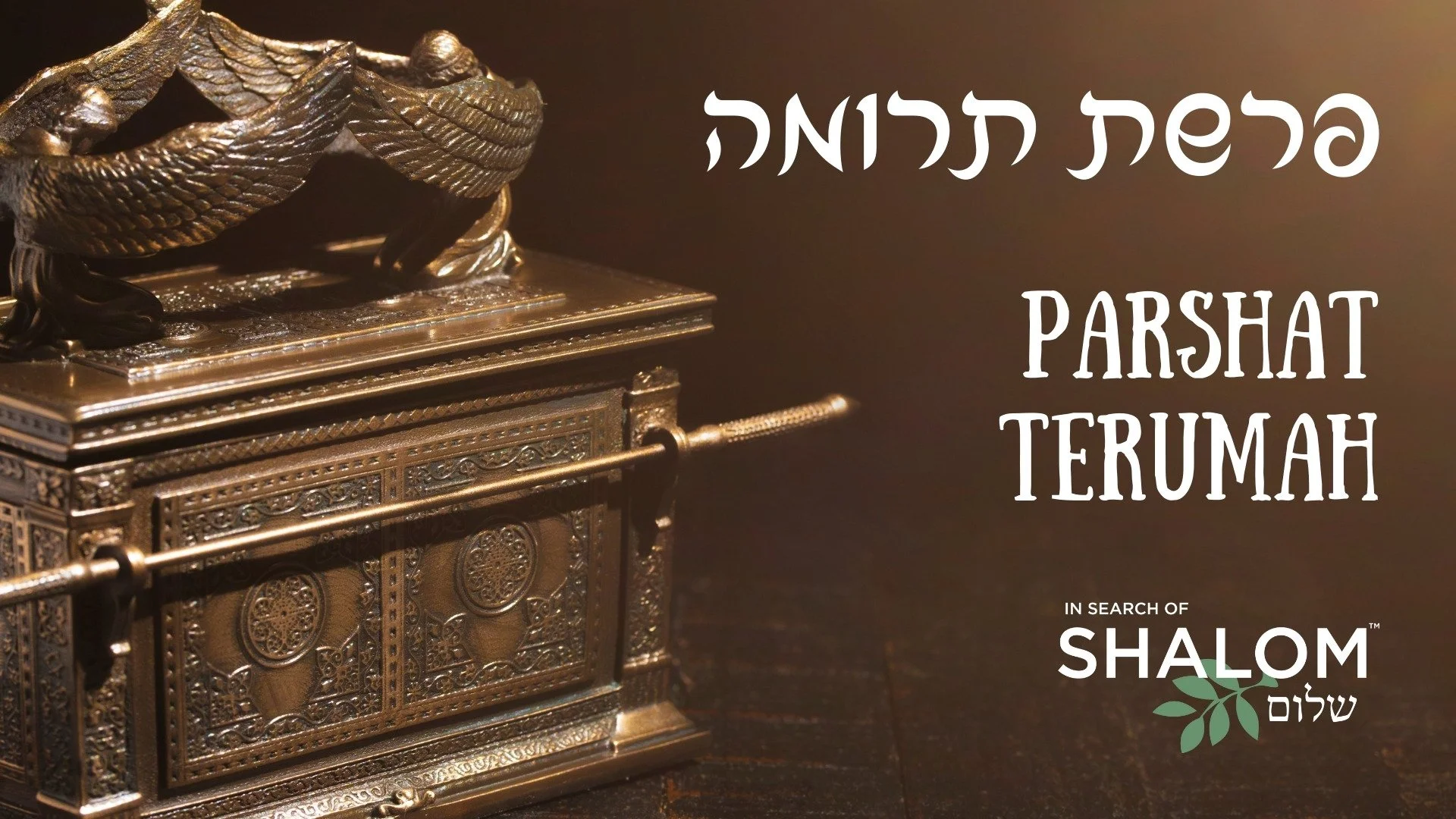#19 — Parshat Teruma
Exodus 25:1-27:19
Overview
In Parshat Teruma the L-RD gives Moses instructions to ask for voluntary contributions from Israelites. These gifts are for the sanctuary God wants to be built, according to specific instructions which He shows Moses (Exodus 25:1-8).
Parshat Teruma then gives the specific instructions for making: the ark of the covenant (Exodus 25:10-16); the ark’s cover, or kapporet (Exodus 25:17-22); the golden table on which the bread was to be laid in G-d’s presence (Exodus 25:29-30); the golden lampstand (Exodus 25:31-40); instructions for the tent-sanctuary with two rooms, the holy place and the most holy place (Exodus 26); the bronze altar; and the fence that makes a court around the tent-sanctuary (Exodus 27:1-19).
Parshat Teruma reveals the L-RD’s intention to live among His people. “Let them make me a sanctuary that I may dwell in their midst” (Exodus 25:8).
The tabernacle is a partial restoration of the Garden of Eden where the L-RD also was personally present (Genesis 3:8). In the tabernacle, the L-RD’s presence remains veiled and access to G-d is still limited but nevertheless it is very real.
The Center of the Sanctuary
The most important place
What is the most important place in the sanctuary? Is it the gold-covered chest which contains the two stone tablets with the ten words of the covenant of God? Is the ark of the covenant indeed the place where the L-RD resides? Is the L-RD enthroned above His commandments which point to the righteousness He expects from His people?
Yes, He is, but thankfully still more is provided here. Something of utmost importance is covering the ark of the covenant. Without it we would be doomed.
The kapporet
The most important place in the sanctuary is the kapporet (כַּפֹּֽרֶת). This cover of the ark of the covenant is much more than a mere lid. [1] It is so central that the Holies of Holies in the temple can be called the “room of the kapporet” (1 Chronicles 28:11). The kapporet specifically is the place where G-d will meet Moses from now on.
The name kapporet encapsulates the most important secret of the tabernacle. It has a message of the utmost importance. It captures what makes it possible for the L-RD to dwell among His people.
The place of atonement
The word kapporet is clearly related to the Hebrew verb to atone (כִּפֶּר) and means instrument or place of atonement. In the context “atonement cover” is a good translation. [2]
The kapporet is where atonement was made annually. The high priest was to bring the blood of the sin-offering for all Israel’s sins to this place on the Day of Atonement (Leviticus 16). Here the L-RD was personally present.
Making the covenant possible
G-d’s design of the interior of the most holy place gives us an extremely important message. G-d’s covenant and presence is not only based on His commandments; on top of them He designs the atonement cover to be placed so His presence can dwell with His people.
The more seriously we take G-d’s commandments and let them impress us as an expression of the righteousness God requires, the more we will appreciate the L-RD’s design. We will understand the need of atonement and thank G-d for it. The centrality of the kapporet shows the absolute need for atonement. We are sinful people and without atonement the L-RD cannot be our G-d, nor dwell among His people.
Messiah, the Ultimate Kapporet
In the tabernacle and temple, atonement was provided by sacrifices. Today we have neither tabernacle nor temple. But G-d shows us in Isaiah 53 that One would come who Himself would be the atonement for the people. This prophecy was fulfilled in the sacrifice of the Messiah who provides ultimate atonement. That’s why the New Covenant scriptures call Yeshua (Jesus) the Messiah “the lamb of God” (John 1:29).
In Parshat Teruma we read how the L-RD starts to dwell among His people again, though in a veiled way. The scriptures of the New Covenant end with a vision which shows how human history will come to a glorious climax. The L-RD will be enthroned in an unveiled way in a completely new Jerusalem filled with His glory.
But in the midst of G-d’s throne there is a special Someone: Yeshua the Messiah, forever standing as the Lamb, our Great Atoner (Revelation 21-22:4). He makes it possible for heaven and earth to be united in the world to come. Forever, He takes the place of the kapporet. The design of the tabernacle is anticipating this grand finale.
That is how everything will be one day. But in the meantime, Yeshua the Messiah is also presented to us as the kapporet. He is personally the place where we sinful people are reunited, truly reconciled, with God.
Here is how Rabbi Gamliel’s most famous pupil (Saul of Tarsus) put it:
For all have sinned and fall short of the glory of G-d and are justified by His grace as a gift, through the redemption that is in Messiah Yeshua, whom G-d put forward as a propitiation (a kapporet!) [3] by His blood to be received by faith (Romans 3:23-25).
We would love to talk with you about this. Don’t hesitate to chat.
———————————
[1] It seems Rashi is doing the latter in his commentary by giving the word kapporet only the meaning “cover,” an interpretation which assumes the Hebrew root כפר can also have that meaning. However, this interpretation ignores the clear connection of the name of the cover with what happens on the cover. If kapporet only means “cover” without a special significance, it is very strange that the holy of holies can be called the “room of the kapporet.”
[2] In English translations, traditionally the name “mercy seat” is used. Although it is true that the kapporet is the place where mercy is found and where the L-RD is seated, this free translation doesn’t bring out the direct connection of the name with atonement.
[3] In the original text, the Apostle Paul uses here the Greek word for “means of atonement.” The same word is used in the Tanakh’s oldest Jewish translation (the Septuagint) to translate kapporet (see also Hebrew 9:5).
The Changed Posture of the Cherubim
Moses also receives the instruction to make two winged golden cherubim. They have to be constructed of one piece with the kapporet. What do the scriptures tell us about cherubim?
Cherubim are mighty angelic beings. Several times the L-RD is described as the one who is enthroned between the cherubim and in the book of Ezekiel they are mighty beings carrying the L-RD’s throne.
But the first time we hear about cherubim they function as “threatening guardians.” After Adam and Eve’s sin we read: He (the L-RD) drove out man, and at the east of the garden of Eden He placed the cherubim and a flaming sword that turned every way to guard the tree of life (Genesis 3:24).
Now however something is remarkably different – and it is very good news: the flaming sword is gone! The cherubim no longer have the posture of threatening guardians. They are bowing down in worship and as the text says, “toward the atonement cover the faces of the cherubim will be” (Exodus 25:21).
Atonement turns off the threat. We can meet the L-RD again.
More from the prophets
Never remove the kapporet
In the book of Samuel we read a history with a serious warning. When the ark of the covenant returns from its Philistine captivity it arrives first in Beth-Shemesh. The inhabitants of Beth-Shemesh make a fundamental mistake: they look in the ark. The result is massive death (1 Samuel 6:19). The men of Beth-Shemesh say “Who is able to stand before the L-RD, this Holy God?”
We can read this history as a warning against irreverence. But maybe more is going on. In order to look into the ark of the covenant the inhabitants of Beth-Shemesh had to lift up the atonement cover.
The message of the Scriptures is very clear: trying to approach G-d without atonement is an absolute dead end.
It is through the atoning sacrifice of the Messiah that G-d wants to welcome us and accept us in love. There is no other way to approach our holy Creator. Without the L-RD’s atonement you’ll have to directly face the tablets of stone which will only condemn you. Never, ever take off the kapporet!

